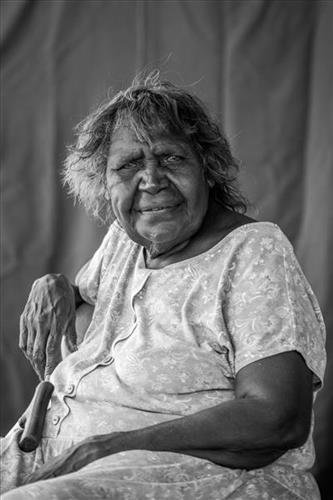110664980129
Garajbebirri Woolmooj-Woolmooj-Ngarri Yarrurn / When we twitch in our bodies
‘When we jump-jump you know la garajbe [twitch in our bodies]. Garajbebirri woolmooj-woolmooj-ngarri yarrurn [When we twitch in our bodies]. Well dambi lingagengarri yimberramenbeyoo jemernngarremboorroo [That is giving us a sign, reminding us about all those people from far away]. That mean we know all the people coming from long way country. That mean stranger [someone who lives far away] is coming.’ Shirley’s painting describes how, in Gija culture, twitches or spasms in certain muscles in the body are signals that someone from far away is about to visit or that something serious has happened to a family member. In this painting, the small circles painted on the body are these specific points where family members are ‘felt’. Shirley says these sensations can signal events that have happened to this relation, such as their dying, falling ill or being in danger. The small grey tree on the right of the body symbolises a relative’s death. It represents traditional Gija burial rites in which a body would be placed on a wooden platform in a tree. The lines emanating from around the groin signify that sensations in this part of the body signal that there is a dangerous person at large that is a threat to them. Shirley explains that each body part is associated with a different kinship relationship. For example, if the muscles at your breast ‘jump’, your children might arrive, they might be in danger or sick or they may have died. This relates both to biological relations and to people who are your classificatory family. According to the Gija kinship system, every person is related to every other through their skin-name. Shirley says she feels her father in her right shoulder and her mother in her right knee and all of those people with the same skin-name as her parents. The vertical lines radiating out from the body near the head represent the skin groups in Gija society.




